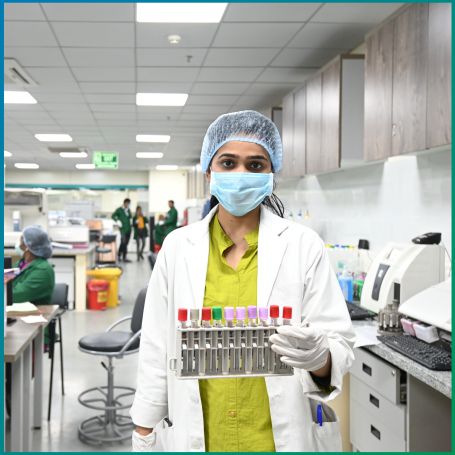
Cryptococcus is typically found in environments like bird droppings or soil and can be inhaled as spores.

The C/S Cryptococcal Test is a diagnostic procedure used to detect the presence of Cryptococcus species in the body, which can lead to serious infections, particularly in individuals with weakened immune systems. Cryptococcus is a type of yeast that can cause cryptococcosis, a potentially life-threatening condition, especially when it affects the central nervous system (CNS). The C/S in this test stands for Culture and Sensitivity, meaning that the sample is cultured in the laboratory to identify the specific pathogen and its susceptibility to different medications, allowing for targeted treatment.
1] Sample Collection: The first step in the test is to collect a sample from the patient. The type of sample will depend on the suspected site of infection:
A] Blood: For suspected systemic infection.
B] Cerebrospinal Fluid (CSF): If meningitis is suspected, CSF is collected via lumbar puncture (spinal tap).
C] Sputum: For suspected pulmonary infection, the patient may be asked to cough up sputum or undergo a bronchoscopy.
D] Skin lesions: If cryptococcosis has caused skin involvement, a swab or biopsy may be taken.
2] Culturing the Sample: Once the sample is collected, it is sent to the laboratory, where it is cultured on specialized media to promote the growth of Cryptococcus. The lab technicians incubate the sample for several days, allowing any Cryptococcus yeast present to grow.
3] Identification of the Pathogen: After culturing, the lab will perform tests to identify the specific strain of Cryptococcus present in the sample. This could involve microscopy, biochemical tests, or molecular techniques such as PCR (polymerase chain reaction) to confirm the presence of Cryptococcus neoformans or Cryptococcus gattii, the two primary species responsible for infections.
4] Sensitivity Testing: Once the pathogen is identified, the next step is to perform sensitivity testing. This involves exposing the cultured organism to various antifungal drugs to determine which ones are most effective at inhibiting its growth. The results help guide the healthcare provider in prescribing the most effective treatment.
5] Reporting Results: After culturing and sensitivity testing, the results are compiled into a report, which is shared with the physician. The report will include information about the identified Cryptococcus species, its antifungal susceptibility profile, and treatment recommendations.
1] Identification of the Pathogen: The test will confirm the presence of Cryptococcus and specify whether it is caused by Cryptococcus neoformans or Cryptococcus gattii. These two species have different environmental sources and may require slightly different treatment approaches.
2] Antifungal Sensitivity: The sensitivity testing will indicate which antifungal drugs are most effective against the identified strain, allowing for a more targeted treatment approach. This is especially important in cases where the infection may be resistant to common antifungal treatments.
3] Treatment Recommendations: Based on the pathogen's sensitivity profile, healthcare providers can choose the most effective antifungal medication, which may include fluconazole, amphotericin B, or itraconazole, depending on the severity and location of the infection.
Choosing Diagnopein for the Cryptococcal Antigen (C/S) test offers several advantages that make it a preferred option in clinical diagnostics. Known for its high sensitivity and specificity, Diagnopein’s test ensures reliable detection of Cryptococcus antigens, especially in immunocompromised patients such as those with HIV/AIDS. The test delivers rapid results, facilitating quicker decision-making and timely treatment, which is critical in managing cryptococcal infections. Additionally, Diagnopein tests are easy to use, cost-effective, and versatile, often allowing for testing across various sample types like serum, cerebrospinal fluid (CSF), and urine. With a strong track record of accuracy and regulatory approval, Diagnopein has earned the trust of healthcare providers, making it a go-to choice for diagnosing cryptococcal infections efficiently and effectively.
1. Culture Method
2. Sample
3. Colony Count
4. Organism(s) Isolated
5. Culture Report: Culture yields growth of
6. Culture isolated after 7 days :
7. Culture isolated after 14 days:
8. Culture isolated after 21 days:
9. Ampicillin
10. Amikacin
11. Amoxicillin clavulanate
12. cefoperazon+sulbactam
13. Cefuroxime
14. Cefepime
15. Cefotaxime
16. Ciprofloxacin
17. Ertapenem
18. Gentamicin
19. Imipenem
20. Meropenem
21. Norfloxacin
22. Nitrofurantoin
23. Piperacillin-tazobactam
24. Trimethoprim-Sulfamethoxazole (Cotrimoxazole)
The test is critical for early detection of cryptococcal infections, which can lead to serious conditions like meningitis, especially in patients with HIV/AIDS or other immunosuppressive conditions.
Yes, it can detect antigens from both Cryptococcus neoformans and Cryptococcus gattii, the two primary species responsible for infections.
The test is usually performed using an immunoassay method, such as an enzyme immunoassay (EIA) or lateral flow test, which detects cryptococcal antigens.
The C/S Cryptococcal Antigen test is highly sensitive and specific, making it a reliable tool for diagnosing cryptococcal infections, particularly in immunocompromised individuals.